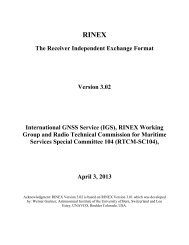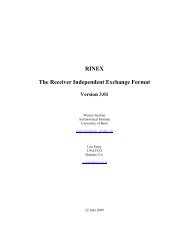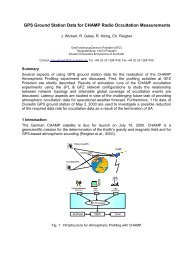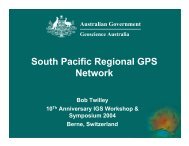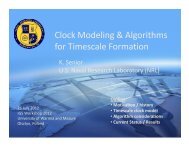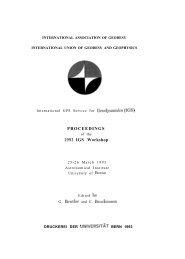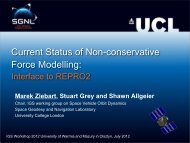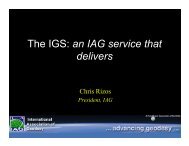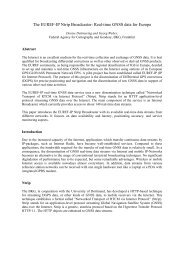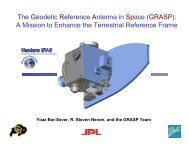IGS Analysis Center Workshop - IGS - NASA
IGS Analysis Center Workshop - IGS - NASA
IGS Analysis Center Workshop - IGS - NASA
You also want an ePaper? Increase the reach of your titles
YUMPU automatically turns print PDFs into web optimized ePapers that Google loves.
SUMMARY OF SESSION 4This session started with presentation of the third position paper which was also distributed to allProcessing <strong>Center</strong>s the week preceding the workshop. The position paper, presented by Blewitt ofJPL, was well prepared and addressed many relevant issues, including the research, organizationand format requirements. The basic concept proposed is a nearly rigorous combination of regionalclusters at the station level via reduced normal equations matrices (’fiducial free adjustments’). Thesecond presentation, by Bock of S10 summarized the S10 approach to distributed processing andregional cluster integration. As pointed out by Bock, the simplest form of distributed processing isthe utilization and fixing of the <strong>IGS</strong> (combined) orbits. In fact, such fixed orbit solutions can beviewed as a back substitution into a global (combined) solution, so the orbit combination discussedin Session 3 is the first and simplest step towards the distributed processing. Bock’s presentation(not distributed before or during the workshop) which included some examples of distributedprocessing is to be integrated with Blewitt and Gendt’s position paper for this workshop report.During the discussions which followed, some concerns were voiced that undue work load increasesfor <strong>IGS</strong> Processing <strong>Center</strong>s may result from this undertaking. It is clear that the <strong>Analysis</strong> <strong>Center</strong>scannot assume the responsibility for reducing and analyzing local (regional) network data. Mostparticipants agreed that distributed processing, when properly designed and implemented, shouldonly mean a minimal work load increase for current Processing <strong>Center</strong>s. Most additional workshould be done regionally or at special <strong>Center</strong>s which were called ‘Network <strong>Center</strong>s’ in the positionpaper and which would be responsible for combining all regional station solutions. However, it wasalso pointed out during the discussion that there is no need to create a new <strong>IGS</strong> <strong>Center</strong> category asproposed in the paper, since all the pertinent functions are already included in the Associated<strong>Analysis</strong> <strong>Center</strong> category (see the terms of references). It was also recognized that <strong>IGS</strong> needs tofoster and encourage regional analysis by stimulating research and providing guidelines.Furthermore, some representations at the governing board level which would specifically representthis effort would be greatly desirable.The position paper suggests the combination at the station level, assuming that the effect ofduplicate data and influence on global orbits is small and can be neglected. Another approachwould be to do the combination at the orbit level. In this way only reduced normals from all globaland regional orbits would be combined resulting in rigorous (global) combined solutions for orbitsand EOP. The station solutions can then be obtained by back substitution, and this approach is infact a rigorous orbit combination including the regional contribution as well. A combination ofthese two approaches is also possible. It is imperative, and it was agreed upon by all participantsthat all the <strong>Analysis</strong> <strong>Center</strong> should develop the capability of producing and distributing reducednormal (’fiducial free’) solutions as soon as possible (some <strong>Center</strong>s have already developed thiscapability). For most <strong>Center</strong>s this will be the only additional effort resulting from the distributedprocessing.It was also recognized that additional products, which may already be available at some <strong>Center</strong>smay be of considerable benefit to regional/distributed processing. More specifically, thetropospheric vertical delays, cycle slip corrected data, satellite and station clock solutions etc. Alsosome additional research is needed, e.g. the significance and mitigation of the overlap data (dataused more than once) in distributed processing. The overlap data can be rigorously removed eitherat regional or global levels, but at significant computational cost increase. The requirements anddesirability of a closer cooperation between IERS (ITRF) and <strong>IGS</strong> in particular with reference tothe <strong>IGS</strong> distributed processing and ITRF reference frame maintenance were also discussed...92




